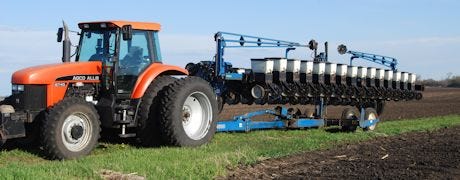May 8, 2013

As you plant corn, soybeans and other crops this spring, keep accurate records. Farmers need to keep track of the date each field is planted, name of the field, how many acres are planted and the crop planted. This reminder comes from Steve Johnson, Iowa State University Extension farm management specialist in central Iowa.

BE DILIGENT, WRITE IT DOWN: Whether you use a pencil and paper, or enter your planting information into an iPad, smartphone or laptop computer from your planter monitor be sure to be timely and accurate. Keep track of planting date, field name, number of acres planted and crop for each field. Accurate information is needed by FSA for the farm program and by RMA for crop insurance purposes. You need to certify your 2013 planted acreage with USDA/FSA by July 15.
"Farmers need to keep accurate planting records," notes Johnson. You have to report that information to your local USDA Farm Service Agency office, to certify your planted acreage. As they do each year, FSA staff will include the information in your acreage report (form FSA 578) which is kept on file at FSA. The information will be used not only by FSA but also by your crop insurance agent to enter into the USDA Risk Management Agency database.
Need to certify planted acreage for farm program and crop insurance
Reporting of planted acreage information to FSA is commonly referred to as "acreage certification." Farmers certify their planted acreage each year. They go to their county FSA office and file their report; the information is entered on form FSA 578.
For 30 years or so farmers have been certifying their planted acreage each year with FSA, so this requirement isn't new. But this spring with the late start on planting and a rush to get the crop in the ground, Johnson is reminding farmers it's important to remember to keep track of their planted acreage information.~~~PAGE_BREAK_HERE~~~
With technology in the tractor cab today, how much does that help farmers keep track of information needed for acreage certification? Some farmers are using digital cards and provide their planting information electronically to their FSA office or to their crop insurance agent. But agriculture generally is in the very early stages of certifying acres electronically, observes Johnson. Most farmers are still writing down the number of acres and crop planted and related information by hand, and the data is transferred to the FSA 578 form by hand.
July 15 is deadline to report 2013 planted acreage
You have until July 15 to report your planted acreage information to your FSA office. But a lot of farmers, as soon as they are done planting, want to get their information to FSA as soon as possible. And local offices are going to get pretty busy in the next few weeks with acreage certification and other farm program activities such as ACRE enrollment and CRP and CSP sign-ups.
The FSA office is where you need to report your planted acreage information and it probably wouldn't hurt to do this in person, just in case someone on the other end of the conversation has a question, or needs a clarification.
Most farmers find it works best to keep records while they are actually planting so they don't forget or don't get fields confused as to which information goes with each field. Some also keep track of fertilizer and herbicide applications, tillage practices used, etc., for each field. But you definitely need to keep track of the planting information that both FSA and RMA require.
Crop insurance deadline for acreage reporting also July 15
Traditionally, the deadline for farmers to certify their planted acreage was June 30. But last year USDA/FSA moved it to July 15 to avoid confusion with the crop insurance reporting deadline. Now both deadlines are July 15.
Since the crop insurance billing date has been moved up to August 15, providing a copy of that acreage report well in advance of the July 15 deadline will assure more timely crop insurance data entry and receipt of your premium notice. The 2013 crop insurance premium is due in September. To avoid a penalty, payment must be received by October 1, which is one month earlier than in the past.
You May Also Like




